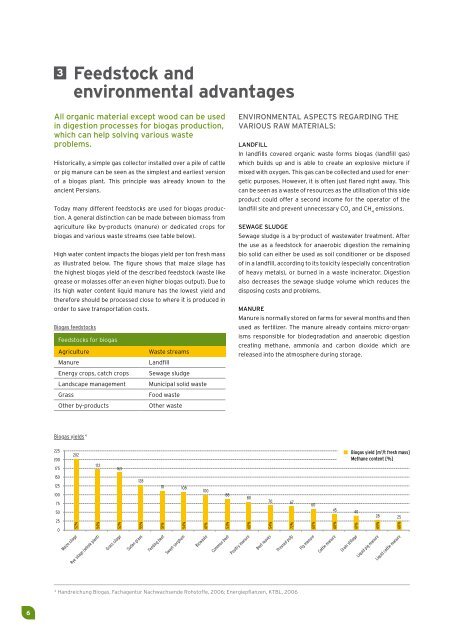A Biogas Road Map for Europe - Aebiom
A Biogas Road Map for Europe - Aebiom
A Biogas Road Map for Europe - Aebiom
You also want an ePaper? Increase the reach of your titles
YUMPU automatically turns print PDFs into web optimized ePapers that Google loves.
6<br />
3 Feedstock and<br />
environmental advantages<br />
All organic material except wood can be used<br />
in digestion processes <strong>for</strong> biogas production,<br />
which can help solving various waste<br />
problems.<br />
Historically, a simple gas collector installed over a pile of cattle<br />
or pig manure can be seen as the simplest and earliest version<br />
of a biogas plant. This principle was already known to the<br />
ancient Persians.<br />
Today many different feedstocks are used <strong>for</strong> biogas production.<br />
A general distinction can be made between biomass from<br />
agriculture like by-products (manure) or dedicated crops <strong>for</strong><br />
biogas and various waste streams (see table below).<br />
High water content impacts the biogas yield per ton fresh mass<br />
as illustrated below. The figure shows that maize silage has<br />
the highest biogas yield of the described feedstock (waste like<br />
grease or molasses offer an even higher biogas output). Due to<br />
its high water content liquid manure has the lowest yield and<br />
there<strong>for</strong>e should be processed close to where it is produced in<br />
order to save transportation costs.<br />
<strong>Biogas</strong> feedstocks<br />
Feedstocks <strong>for</strong> biogas<br />
Agriculture Waste streams<br />
Manure Landfill<br />
Energy crops, catch crops Sewage sludge<br />
Landscape management Municipal solid waste<br />
Grass Food waste<br />
Other by-products Other waste<br />
<strong>Biogas</strong> yields 4<br />
225<br />
200<br />
175<br />
150<br />
125<br />
100<br />
75<br />
50<br />
25<br />
0<br />
202<br />
52%<br />
Maize silage<br />
172<br />
54%<br />
Rye silage (whole plant)<br />
163<br />
52%<br />
Grass silage<br />
128<br />
55%<br />
Sudan grass<br />
111<br />
51%<br />
Feeding beet<br />
4 Handreichung <strong>Biogas</strong>, Fachagentur Nachwachsende Rohstoffe, 2006; Energiepflanzen, KTBL, 2006<br />
108<br />
54%<br />
Sweet sorghum<br />
100<br />
61%<br />
Biowaste<br />
88<br />
53%<br />
Common beet<br />
ENVIRONMENTAL ASPECTS REGARDING ThE<br />
VARIOUS RAw MATERIALS:<br />
LANDfILL<br />
In landfills covered organic waste <strong>for</strong>ms biogas (landfill gas)<br />
which builds up and is able to create an explosive mixture if<br />
mixed with oxygen. This gas can be collected and used <strong>for</strong> energetic<br />
purposes. However, it is often just flared right away. This<br />
can be seen as a waste of resources as the utilisation of this side<br />
product could offer a second income <strong>for</strong> the operator of the<br />
landfill site and prevent unnecessary CO and CH emissions.<br />
2 4<br />
SEwAGE SLUDGE<br />
Sewage sludge is a by-product of wastewater treatment. After<br />
the use as a feedstock <strong>for</strong> anaerobic digestion the remaining<br />
bio solid can either be used as soil conditioner or be disposed<br />
of in a landfill, according to its toxicity (especially concentration<br />
of heavy metals), or burned in a waste incinerator. Digestion<br />
also decreases the sewage sludge volume which reduces the<br />
disposing costs and problems.<br />
MANURE<br />
Manure is normally stored on farms <strong>for</strong> several months and then<br />
used as fertilizer. The manure already contains micro-organisms<br />
responsible <strong>for</strong> biodegradation and anaerobic digestion<br />
creating methane, ammonia and carbon dioxide which are<br />
released into the atmosphere during storage.<br />
80<br />
60%<br />
Poultry manure<br />
70<br />
54%<br />
Beet leaves<br />
67<br />
72%<br />
Pressed pulp<br />
60<br />
60%<br />
Pig manure<br />
45<br />
60%<br />
Cattle manure<br />
<strong>Biogas</strong> yield [m 3 /t fresh mass]<br />
Methane content [%]<br />
40<br />
61%<br />
Grain stillage<br />
28<br />
65%<br />
Liquid pig manure<br />
25<br />
60%<br />
Liquid cattle manure


